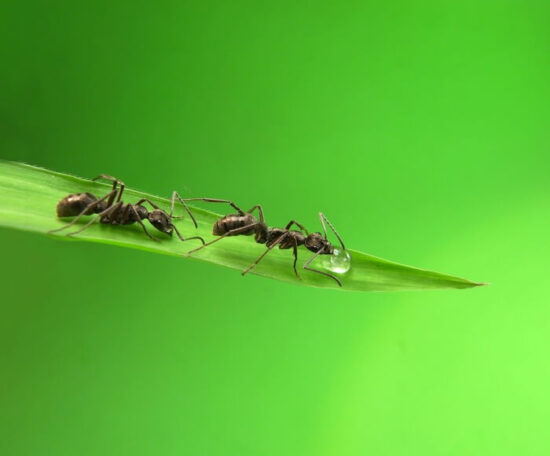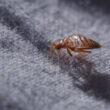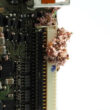Getting rid of ants in your lawn isn’t the impossible task that many homeowners think it is. It simply requires a bit of knowledge and effort!
This guide will teach you how to get rid of ants in your yard, and keep your grass free of these pests.
Table of contents
Are All Ants In Your Yard A Bad Thing?
Ants are one of the most common outdoor insects you’ll encounter. And while they can be a nuisance, not all ants are bad.
Most are not considered to be an issue at all. Instead of causing harm, those beneficial species actually do a lot of good for your yard!
They can aerate the soil to make way for healthy grass. Plus, those bugs will pollinate flowers and fruits, feed on termites, and drive ticks away.
Ants usually offer a good biological boon to a garden. Unfortunately, there are just as many “bad” species as they are good.
There’s no denying that ants can wreak havoc on your perfectly manicured lawn. Small mounts and ant hills aren’t a huge problem, but larger ant populations can create massive nests that stretch several feet under the surface.
Quick Tip: Just because most of the tunneling occurs under the ground doesn’t mean that the damage is invisible. Not only does it result in massive dirt mounds, but these pests can damage grass root systems. They can also ruin soil quality and cause tons of damage to gardens and fields.
When you spend so much time and money making your sod look pristine, ants can throw a real wrench in the works!
Those tall mounds can make lawn maintenance a hassle as well. Larger colonies create multiple dead zones in the grass. Meanwhile, the raised entrance is a nightmare when mowing.
Some species can also attract unwanted pests. For example, farming ants like to herd aphids to collect that sweet honeydew. Unfortunately, the aphids can migrate to nearby plants and ruin your garden!
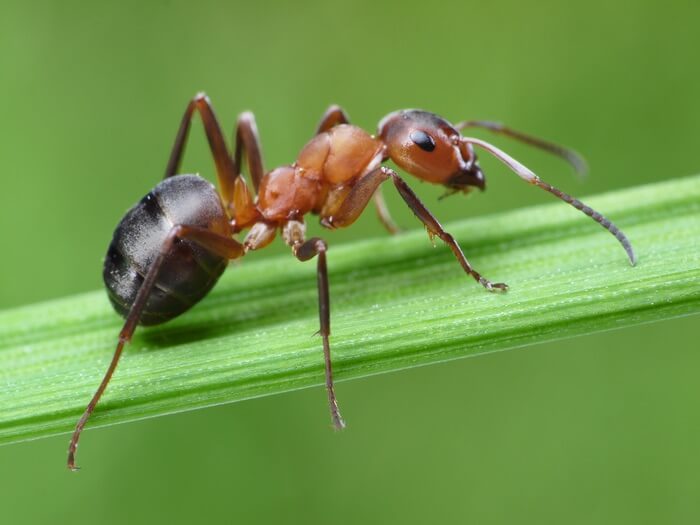
On top of all that, several species can bite and sting. Most will mind their own business, but all it takes is a slight disturbance to send colonies into a frenzy. With backyards being a haven for pets and kids, bites are far too common.
It’s true that not all ants in your yard are bad. But the ones that can cause problems will make themselves known pretty quickly! That’s why it’s important to know how to get rid of ants in your lawn.
Types Of Ants You’ll Find In The Grass
Several ant species can reside in your yard. The exact varieties depend entirely on your climate and location, but the most common are easy to identify in grassy yards.
Prevalent ant species in yards include the mound ant, the farming ant, and the army ant.
Mound ants, also known as field ants, are some of the worst to deal with. They create gargantuan nests that can span several feet. Luckily, most stick to empty fields. But if you have a big enough yard, you may spot their mounds forming.
Farming ants are known for their cultivation of aphids. Aphids produce honeydew, which is a delicacy for this species and many others. By farming the aphids, they are notorious for spreading plant diseases and causing garden infestations.
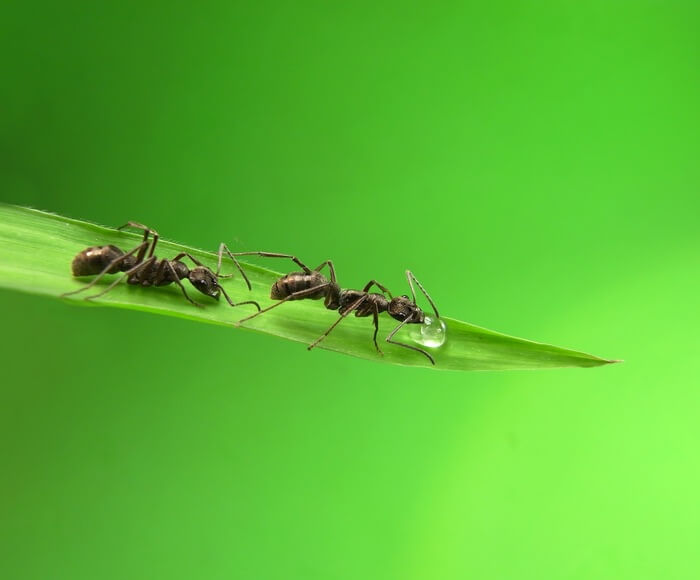
Army ants are the aggressive little brown pests that flock to decaying bugs and dropped food. They’re impressive scavengers that like to move in large numbers while they search.
Another common lawn ant you might encounter is the fire ant. They are reddish-brown and have a very painful sting. Fire ants can form sizable colonies in well-aerated soil and dirt-filled environments.
Your lawn can also contain home-invading species. Carpenter ants (don’t forget to look for them in trees), black ants, ghost ants, pavement ants, and pharaoh ants are all common.
These species will often start nests outside, too. But if scouts spot viable living conditions inside your home, the colony can move! If you spot any of those species near doors, windows, and walls, it’s important to get rid of them as soon as possible before they migrate.
How To Get Rid Of Ants In Your Lawn Naturally
Despite all the species out there, it’s pretty easy to get rid of ants in your lawn regardless of the type you’re dealing with. They’re resilient and quick to proliferate, but they’re no match for some proven extermination strategies.
Here are some of the best ways to get rid of ants in your yard naturally.
1. Diatomaceous Earth
You can’t go wrong with diatomaceous earth!
This substance comes in powder form and is readily available at most garden centers and big-box stores. You might have heard your parents or grandparents touting the efficiency of diatomaceous earth. And trust us, the effectiveness of it is more than just an old wives tale.
This powder does a fantastic job getting rid of ants in your lawn.
You see, the powder is made of microscopic fossilized remains. The remains are that of aquatic algae called diatoms.
Manufacturers collect the diatoms and crush them into a fine powder. To us, the powder has a similar consistency and texture to flour or baking soda. But to tiny ants, it’s downright lethal!
On a microscopic level, the powder particles are sharp and highly abrasive. Tossing some diatomaceous earth onto the ants causes injuries that let body fluids escape. It doesn’t take long until the ant is dehydrated and dead!
Quick Tip: Use a bag of diatomaceous earth on large mounds, known ant trails, and any visible insects you see. You can also mix it with some water to pour down ant hills. Either way, the powder is very effective.
Plus, it’s a natural and eco-friendly form of pest control that won’t compromise the health of your lawn.
2. Water & Soap
Soap and water do a couple of things that make them a great tool for getting rid of ants in your lawn.
The most obvious is erasing ant trails. Spritzing some soapy water onto known trails can throw the colony off and force it out of your yard.
If you apply it directly to ants, it can slowly also suffocate and drown them.
The soapy mixture can clog up breathing tubes and prevent proper respiration. More importantly, however, is its ability to ensure drowning.
In normal conditions, ants are very water resistant. Their bodies are somewhat water phobic, which helps them stay on top of water at all ties. Plus, their small bodies and agile legs create impressive buoyancy that prevents sinking.
Soap will break down that water resistance and force ants to sink. When used liberally, soapy water can drown ants in minutes!
For the best results, create a diluted solution using one tablespoon of soap and one quart of water.
Standard dish soap works just fine. However, we always recommend using an all-natural alternative when possible to minimize the effects on your lawn. Castile soap works great!
Give the mixture a good shake and spray it anywhere you see ants.
3. Vinegar
Vinegar is another substance that can kill ants in your yard on contact!
Acidic by nature, it slowly dissolves the ant’s protective exoskeleton. Not only that, but ants hate the smell! As a result, it works both as an ant killer and an ant deterrent.
The best way to use vinegar is to dilute it with water. An equal amount of white vinegar and water should do the trick. Like the soap solution, spray it liberally on ants, trails, and mounts.
Just be careful about how much you apply.
Quick Tip: While vinegar is all-natural, there is a chance that it could harm plants through dehydration. Furthermore, the acidic solution could throw off the pH balance of the topsoil, which could change the way a plant develops.
4. Cayenne Pepper
This fiery spice is a great weapon for your fight against lawn ants.
Ants don’t like walking on powdery substances in general. As a result, any spice will work to create hard boundaries that ants won’t cross.
However, cayenne pepper also has the benefit of a strong aroma. Ants hate it, and will actively avoid it as much as possible. You can use this to your advantage a couple of different ways.
The first is by drawing a circle around the mound. Doing so stops ants from escaping. It confines them to one location to prevent foraging and relocation.
You can also sprinkle some on known ant trails to throw these pests off the scent.
For the final blow, create cayenne water. Then pour it down the ant hill to kill these insects.
Quick Tip: As a bonus, cayenne makes the spot unlivable. As a result, future ants can’t move in to rebuild the colony!
5. Cinnamon Oil
Cinnamon oil is another substance that can be used to get rid of ants in your lawn. The essential oil is quite intense in the smell department, making it a great all-natural deterrent.
Add a few drops to a clean water bottle and go to town on any known ant spots. Douse trails, mounds, and any other place you know the ants frequent.
Make sure to exercise caution around plants. Too much of the oil might harm more delicate cultivars.
6. Salt
Salt is one of the best desiccants around. A desiccant is a hygroscopic substance that slowly dries out anything it touches. That includes ants!
Use the salt to cover ants and their living spaces. You can use dry salt or saltwater. Standard dry salt tends to work more efficiently.
Quick Tip: As always, exercise caution here. While salt can dehydrate and get rid of ants in your yard, it can do the same to plants. Don’t spray too much of it around your garden. Otherwise, you’ll end up with yellow plants!
7. Mint Plants
Mint plants don’t kill ants in your yard like some of the other substances we went over. However, it can deter future ants from moving in. When used strategically, you can use these plants to drive ants out of your lawn.
These insects hate the smell of mint. It’s far too pungent for their delicate olfactory organs.
Purchase some live plants at your local garden center and put them around the ant hill. Mint plants are pretty affordable. Plus, you can use the leaves for drinks and desserts!
Position the plants in a grid around the mound. After a few days, you might notice the ants lining up to migrate to another spot. Follow them with the plants until they are out of your grass and property!
8. Baking Soda
Baking soda is a multi-purpose powder that’s quite effective at getting rid of ants in your lawn.
You have a couple of ways to use it.
If you want to keep things simple, sprinkle the powder onto mounds and visible ants. While not as abrasive as diatomaceous earth, baking soda can kill ants by causing dehydration. Plus, the powdery texture slows ants down significantly.
For a bigger punch, you can mix the soda with powdered sugar. With this technique, you’re creating a bait that the ants will bring to the colony and eat. Ants love powdered sugar and willingly consume the soda just to get a taste of the sweet stuff.
When they do, the baking soda gets to work killing them from the inside. It disrupts the ant’s natural chemistry and dries them out!
Quick Tip: Another option is to use it with vinegar to create an explosive reaction! Sprinkle the baking soda into the ant hill. Then, follow up with pure vinegar.
The foam will work its way through the various tunnels of the nest to kill as many ants as possible.
9. Orange Peels
Don’t toss those orange peels in the trash can. Use them in your yard instead!
Orange peels are toxic to ants. They contain a unique compound called d-limonene. The compound destroys the wax coating inside the ant’s respiratory system, leading to a slow death after ingestion.
Interestingly enough, ants don’t eat orange peels directly. Like mint and cinnamon, the strong smell is too overbearing for ants. As a result, they avoid it.
However, the orange peels do poison nearby fungi. The ants will eat the fungus and inadvertently ingest the d-limonene compound.
It’s an interesting process that doesn’t take much to initiate. Just spread the peels around your lawn and wait for the ants to die.
More Extreme Methods
Do you need some more robust methods for killing ants in your yard?
More severe ant infestations may require stronger methods of extermination. Fortunately, the products you need are readily available at most stores. It’s not hard to find chemical insecticides, bait traps, and other ant-killing products.
Most are exclusively marketed for dealing with ants, so they will be easy to pick out.
You may see chemical sprays that eradicate ants on contact. Those products are effective at killing ants that are out in the open (in grass for example), but they don’t always address the larger colony.
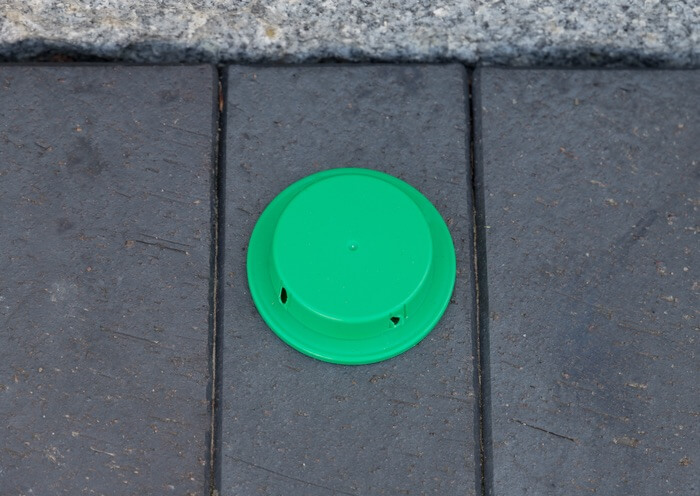
For that, you’ll need bait-style traps (killing ants with borax is a common method). Granular ant killers combine chemical toxins with known ant food. The ants find the bait, bring it to their nest, and consume it as a colony.
Unbeknownst to them, the tiny grains have slow-acting poison. By the time the ants start dying off, many in the nest have eaten it. If you’re lucky, the queen might have a taste, too. Once the queen dies, the entire colony dies with her.
It’s obvious that extreme ant extermination methods work well. However, they do come with some risks.
Not only do they pose a health and safety risk for your family, but you could end up ruining your grass and other parts of the yard.
You have to be extra careful when it comes to application. Read the instructions carefully and avoid applying the products to garden beds and plants.
Quick Tip: If you’re using bait products, make sure to place them in areas where wild animals, children, and pets can’t reach. Those poisons can be lethal to much larger creatures as well.
How To Discourage Ants From Coming Back To Your Lawn
Discouraging ants from invading your lawn is not an easy task. Ants gravitate to well-draining soil, locations with ample access to food, and watered fields. Your lawn is the perfect place to set up a colony.
To prevent future infestations from occurring, you have to be proactive about making your yard as unappealing to these pests as possible.
Contrary to popular belief, you don’t have to sacrifice lawn maintenance to keep it pest-free.
Start by sticking to a regular lawn maintenance schedule. Cut the grass frequently to prevent overgrowth and excessive shade. Keep the grass low to ensure that the soil is exposed to as much sunlight as possible.
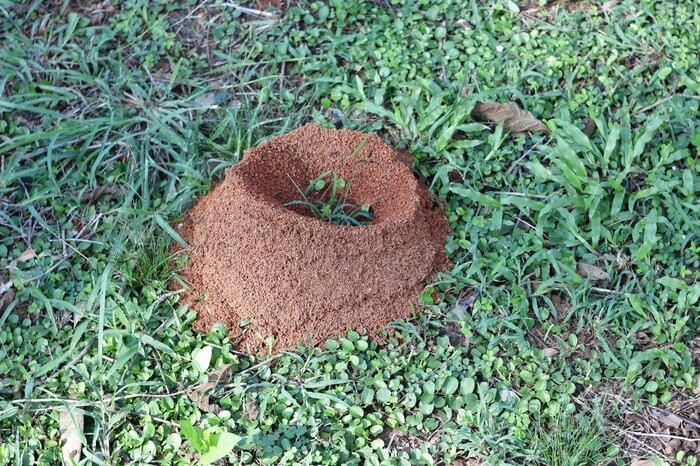
If you have any sources of food that attract ants nearby, move them. Some common attractants are dirty garbage cans, compost piles, and loose trash.
Invest in a sealed garbage can to stop smells from percolating through the air. Then, move your compost away from your manicured lawn. Sealed compost bins that are lifted off the ground are available as well to minimize pest access.
Once you deal with any attractants, consider planting deterrents! Ant-repelling plants like mint, sage, rosemary, thyme, garlic, and more are perfect for keeping ants out. Fragrant flowers like marigold and lavender do just fine, too.
Most aromatic herbs and plants will work. Place those plants strategically around your yard to make it a no-go zone for ants.
Finally, address any ant hills that pop up as soon as possible. Flood the mounds and take advantage of all the available natural killers to get rid of the ants in your lawn.
Closing Thoughts
Now that you know how to get rid of ants in your lawn, it’s time to get to work! As you can see, many of the methods listed above aren’t complex. All they require is some time and consistency to help you reclaim your yard.
Give these a shot and let us know how they work for you!
